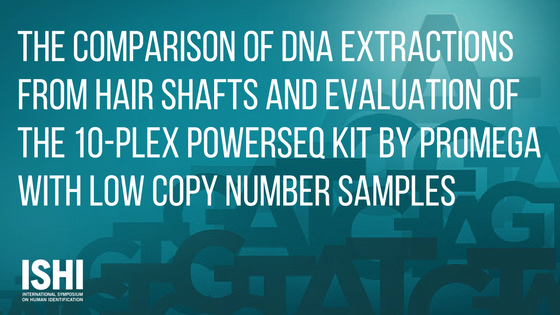DNA extraction from hair shafts is a common practice in forensic casework. However, the amount of nuclear (n) DNA recovered from hair shafts is usually below what is needed for STR analysis, leading forensic scientists to rely on mitochondrial (mt) DNA analysis due to its high copy number characteristics.
Submitted by: Jamie Gallimore, Penn State University
Three DNA extraction methods for hair shafts were compared and evaluated: hair lysis and size-exclusion filtration (LF), hair grinding, lysis, PCIA purification and size-exclusion filtration (GLPF), and lysis and magnetic bead purification (LMB).
Although extraction methods have been compared before, these three protocols have not been evaluated side-by-side using an mtDNA-based qPCR method (mtqPCR) as the assessment tool, followed by Promega’s 10-Plex massively parallel sequencing (MPS) approach to mtDNA analysis. The quantitation values showed the LMB method to significantly outperform the LF and GLPF methods.
The samples appeared to have issues with coverage in certain areas of the control region, but this could have been due to instrumental setbacks. Although there was some lack of sufficient coverage, this preliminary experiment did show that some data can be retrieved from low copy number samples using the 10-Plex MPS approach.
Currently, many laboratories use a version of the LF or GLPF methods. Hopefully this project shows the community that there is a possibly better method for hair extraction, leading to better sequencing data whether it is Sanger or MPS.
Special thanks to Dr. Mitchell Holland and Dr. Jennifer McElhoe for the abundant amount of advice and guidance, our colleagues at Promega (Spencer Hermanson, Margaret Ewing, Doug Storts), Western Carolina University (Mark Wilson, now with Battelle, and Brit Bintz), Mitotyping Technologies (Shelley Johnson, Gloria Dimick), and NIST (Pete Vallone, Margaret Kline) for their support and advice. Thanks to the Forensic Science Program, Biochemistry & Molecular Biology Department at Penn State for their support of a Research Assistantship.
This project shows a potentially better method for hair extraction, leading to better sequencing data. Share on X
I joined Dr. Holland’s laboratory last fall as a graduate student with Penn State’s Forensic Science Department. He introduced me to the various possibilities with mitochondrial DNA research and the needs of the forensic field. This led to the development of hair extraction project. Currently I am looking at using what I have found and applying it to a larger study characterizing heteroplasmy drift among hair samples within one individual.
WOULD YOU LIKE TO SEE MORE ARTICLES LIKE THIS? SUBSCRIBE TO THE ISHI BLOG BELOW!


